Easthampstead, Berkshire
Up to 1834
In 1777, Winkfield had a workhouse accommodating up to forty inmates. In 1832, the dozen or so residents comprised old men and women, and a few orphan children.
Binfield had a workhouse once on what is now Red Rose. In 1832, it was said to be a 'poor house under the care of a Master and Matron' and occupied by fourteen adults, ten of whom were over 70, three boys and a young child. Its location, as the "old workhouse", is shown on the 1881 map below.
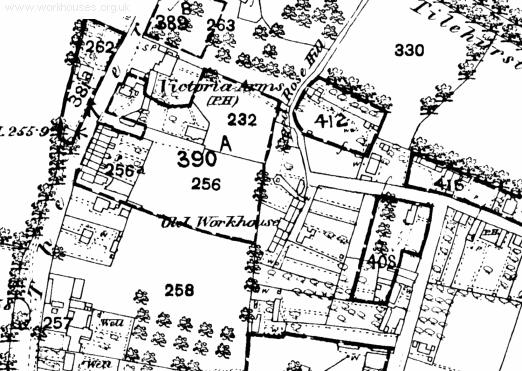
Binfield former parish workhouse site, 1881.
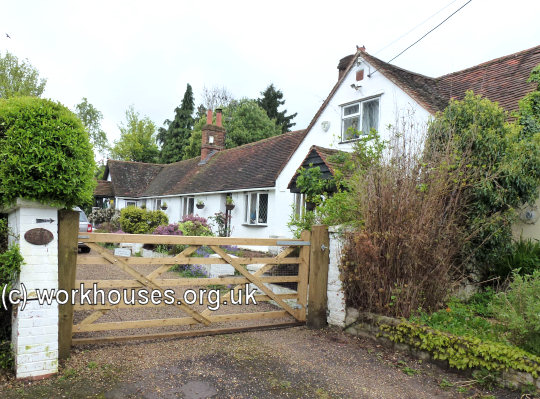
Former Binfield parish workhouse, 2014.
© Peter Higginbotham.
What later became the Easthampstead Union workhouse incorporated a group of almshouses dating from 1826 at the south of St Mary Magdalen and St Michael's church in Easthampstead.
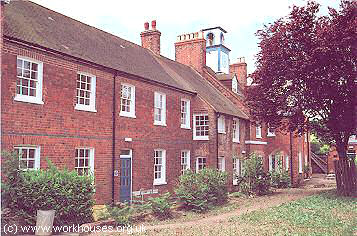
Easthampstead former almshouses, 2000.
© Peter Higginbotham.
The history of these buildings is told in a plaque on the front of the building:
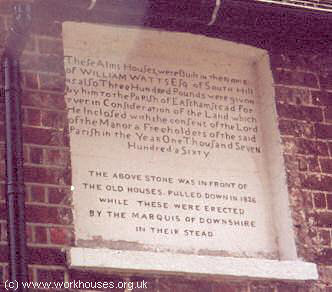
Easthampstead, 2000.
© Peter Higginbotham.
The above stone was in front of the old houses pulled down in 1826 while these were erected by the Marquis of Downshire in their stead.
A local story has it that the clock-tower on top of the houses was donated by a local dignitary. He had originally planned to make the donation to the church of St Mary Magdalene and St Michael which stands opposite. He apparently changed his mind after the local clergy refused to trim a overhanging tree in the churchyard which regularly knocked off his hat!
In the 1770s, Winkfield had a parish workhouse able to accommodate up to 40 inmates.
After 1834
Easthampstead Poor Law Union was formed on 27th July 1835. Its operation was overseen by an elected Board of Guardians, 10 in number, representing its 5 constituent parishes as listed below (figures in brackets indicate numbers of Guardians if more than one):
Berkshire:
Binfield (2), Easthampstead (2), Sandhurst (2), Warfield (2), Winkfield with Ascot (2).
Later Additions: Crowthorne (1894-1930).
The population falling within the union at the 1831 census had been 6,980 — ranging from Easthampstead (population 647, and unusual in being the smallest parish in a Union bearing its name) to Binfield (2,145). The average annual poor-rate expenditure for the period 1832-35 had been £2,700.
The location and layout of the site is shown on 1871 map below:
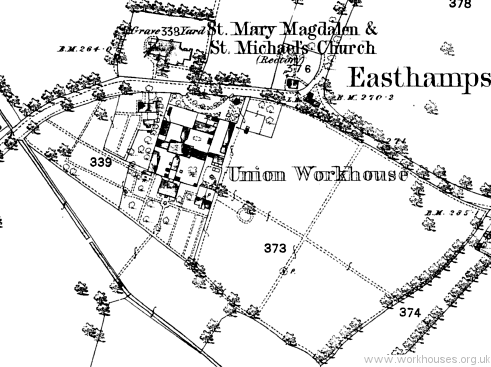
Easthampstead site, 1871.
The Poor Law Commissioners authorized an expenditure of £400 for adapting the buildings for use as a workhouse. The main addition appears to have been a three-storey block, now demolished, at the rear of the main row of houses. The building's layout at this stage appears to have resembled the cruciform layout popular for newly built workhouses in the 1830s.
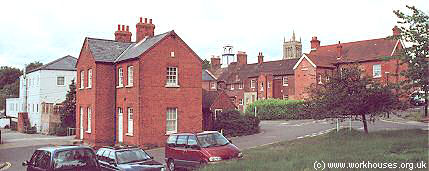
Easthampstead site from the south-east, 2000.
© Peter Higginbotham.
Later additions to the site include an infirmary in 1869, and a board-room block in 1901. Both of these were located to the north-east of the workhouse.
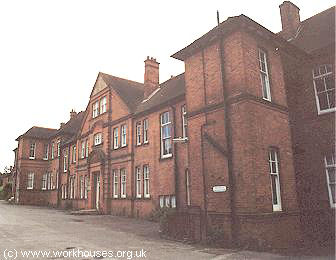
Easthampstead infirmary block, 2000.
© Peter Higginbotham.
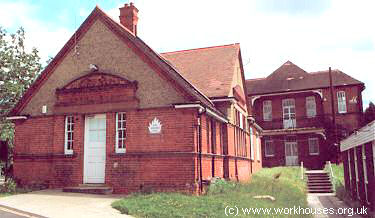
Easthampstead board-room block, 2000.
© Peter Higginbotham.
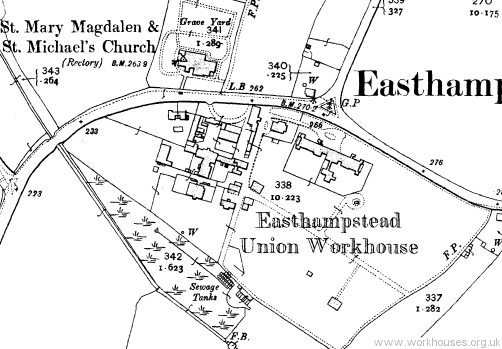
Easthampstead site, 1912.
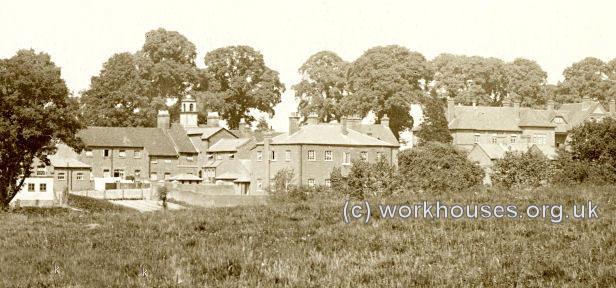
Easthampstead from the south-west, c.1912.
© Peter Higginbotham.
In 1928, James Wilder, 61, an inmate of the institution for more than six years, made a series of charges against the workhouse officials. He asserted that while he was in the infirmary, he had had to wear the same underclothing for six weeks without a change, that there was a shortage of soap, that no night nurse had been on duty since Christmas, and that the master had not carried out the regulations. A committee of inquiry was set up and found that the charges were without foundation. As a result of his actions, Wilder was placed om bread and water for week, received no tobacco allowance for six months, and could take no leave for twelve months.
In 1930, the workhouse was taken over by Berkshire County Council and became a Public Assistance Institution. It joined the National Health Service in 1948 as Church Hill Hospital.
Although part of the site continues to operate as Church Hill House Hospital, the old almshouses and adjacent buildings have been refurbished and redeveloped as private residential accommodation.
Cottage Homes
In the early 1900s, the Easthampstead Union operated a cottage home for pauper children at Wokingham Road, Bracknell. In around 1925, the home moved to new premises at 76 Binfield Road, Bracknell. The Binfield Road site later became the St Anthony's Boys' Home / Hostel.
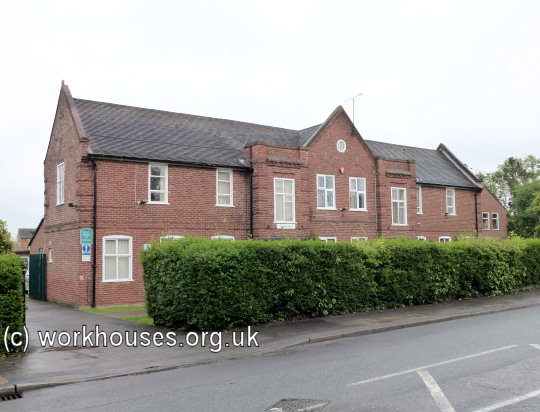
Former Easthampstead Cottage Home, 2014.
© Peter Higginbotham.
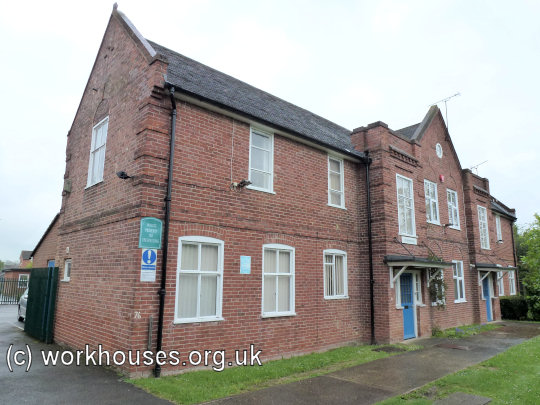
Former Easthampstead Cottage Home, 2014.
© Peter Higginbotham.
Staff
Inmates
Records
Note: many repositories impose a closure period of up to 100 years for records identifying individuals. Before travelling a long distance, always check that the records you want to consult will be available.
- Berkshire Record Office, Berkshire Record Office, 9 Coley Avenue, Reading, Berks RG1 6AF. Holdings include Guardians' minute books (1870-75, 1880-1930); Births (1849-1914); Deaths (1848-1914); etc.
Bibliography
- Higginbotham, Peter Workhouses of London and the South East (2019)
Links
- None.
Unless otherwise indicated, this page () is copyright Peter Higginbotham. Contents may not be reproduced without permission.


